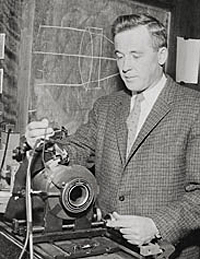In Memoriam
 OPTICAL ENGINEER: Hopkins was among the first to recognize the role lasers would play in the study of optics. (Photo: Department of Rare Books, Special Collections, and Preservation)
OPTICAL ENGINEER: Hopkins was among the first to recognize the role lasers would play in the study of optics. (Photo: Department of Rare Books, Special Collections, and Preservation)Robert Hopkins ’45 (PhD), the director of the University’s Institute of Optics from 1954 to 1965, and a faculty member at the institute from 1945 until the 1980s, died July 4. He was 94.
Widely regarded as the “father of optical engineering,” Hopkins was among the first scientists to use the computer to design optical systems and among the first to recognize the role the laser would play in the future of solid state and quantum physics.
After earning his doctorate from Rochester, Hopkins joined the faculty where he trained hundreds of students who went on to leading positions in optics.
“I remember my first class with Bob when he said that after a while you can look at a lens design and tell whether it will work,” says Duncan Moore, the Rudolph and Hilda Kingslake Professor of Optical Engineering at Rochester. “I was incredibly doubtful, but about 10 years later when I taught optical engineering, I realized he was right.”
Moore, who is also the vice provost for entrepreneurship at the University, adds that Hopkins “was a great entrepreneur at a time that the role of a university in economic development was 40 years in the future.”
In 1953, Hopkins cofounded Tropel Inc., a firm to manufacture precision optical systems and instruments for industry. His achievements at building Tropel—along with the success of one of his professional colleagues, John Bruning—led to the creation of the Robert E. Hopkins Center for Optical Design and Engineering in 2007. A gift from Bruning, the former CEO of Corning Tropel Corp., helped establish the Hopkins Center.
Hopkins brought innovations to Rochester as well as other universities. In his early years at Rochester, he traveled frequently to Ithaca to use an early computer at Cornell University. In 1955, he brought the first computers to Rochester. His lens designs included the Todd-AO lens used to produce high definition, wide aspect–ratio films shot on large format film, beginning with Oklahoma! in 1955. The technology made possible the widespread creation and projection of wide-screen movies. In 1963, he organized the “Laser Road Show” for the National Science Foundation to introduce laser technologies at colleges, universities, and corporations.
“Bob gave enormously to the world of optics as a scientist, an engineer, an entrepreneur, and leader,” says Bruning, “and will continue to inspire future generations of students.”
—Sharon Dickman
Sharon Dickman is University spokesperson.
